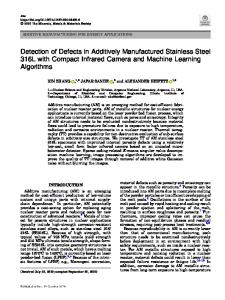Formation of Austenite in Additively Manufactured and Post-Processed Duplex Stainless Steel Alloys
- PDF / 9,253,505 Bytes
- 18 Pages / 593.972 x 792 pts Page_size
- 106 Downloads / 316 Views
NTRODUCTION
DUE to their good strength and corrosion resistance, duplex stainless steels (DSS) are used frequently in marine applications,[1] nuclear power generation,[2] oil and gas exploration, and refining.[3] These attractive properties are obtained by producing a balanced ferrite/ austenite microstructure through a series of highly controlled thermo-mechanical processing steps.[4] However, thermal processing or service in high temperature environments can disrupt this targeted ferrite/austenite
A.D. IAMS is with the Department of Material Science and Engineering, The Pennsylvania State University, University Park, PA 16802 and also with the Applied Research Laboratory, The Pennsylvania State University, University Park, PA 16802. J.S. KEIST is with the Applied Research Laboratory, The Pennsylvania State University. T.A. PALMER is with the Department of Material Science and Engineering, The Pennsylvania State University and also with the Department of Engineering Science and Mechanics, The Pennsylvania State University, University Park, PA 16802. Contact e-mail: [email protected] Manuscript submitted July 15, 2019.
METALLURGICAL AND MATERIALS TRANSACTIONS A
phase balance and promote the formation of secondary phases,[5] such as secondary austenite,[6,7] r,[8–11] M23C6,[12,13] and Cr2N.[12] The rapid heating and cooling cycles prevalent in welding operations have been shown to disrupt the ferrite/austenite phase balance in DSS components.[4] To address this problem, austenite forming elements, such as nickel, are added to the weld filler materials in order to overmatch the wrought DSS alloy composition and promote the formation of a balanced ferrite/ austenite microstructure.[14–21] Another method for promoting higher austenite levels in the weld metal involves nitrogen additions to the shielding gas.[14–16,18,19,22] Post-weld heat treatments can also be implemented to increase the amount of austenite initially formed during welding and produce microstructures with nearly equal fractions of austenite and ferrite.[15,23,24] Additive manufacturing (AM) processes display thermal histories similar to those present in welding and often use powder feedstocks with compositions that fall within the ranges defined for standard wrought alloys.[25] Therefore, autogenously welded wrought alloys can serve as a representation for the microstructures expected in AM processing. These autogenously
welded DSS alloys typically display a ferritic microstructure with low levels of austenite, composed primarily of grain boundary and Widmansta¨tten austenite interspersed with low levels of intragranular austenite.[14–16,19,21,26–30] Changes in the heat input when moving from gas tungsten arc (GTA) to laser or electron beam energy sources have been found to impact the cooling rates and resulting microstructures. For example, at the higher heat inputs associated with the GTA source, cooling rates are on the order of 101 K/s to 103 K/s, while those associated with the lower heat input laser and electron beam processes are on the order of 1
Data Loading...











